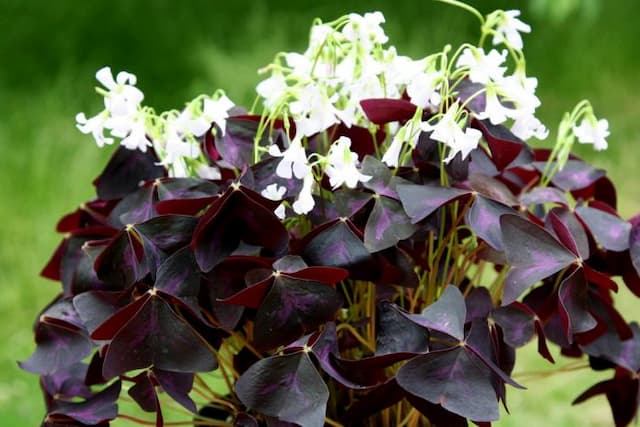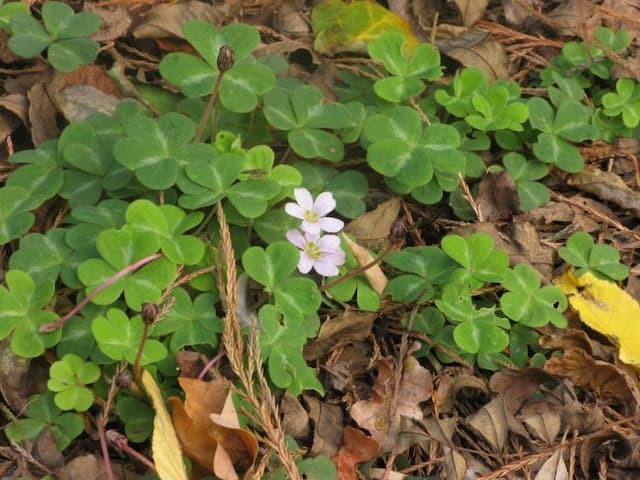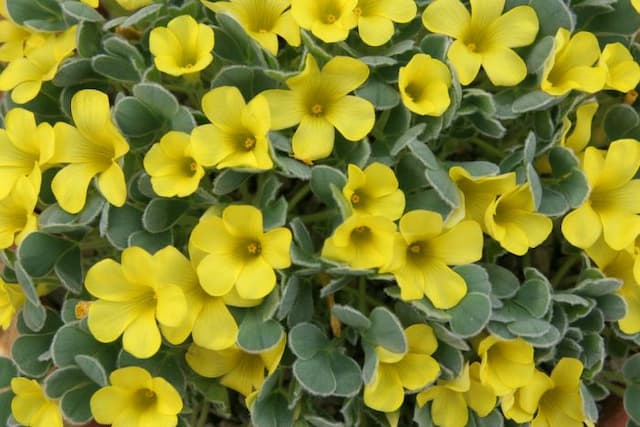Scurvy Grass Sorrel Oxalis enneaphylla 'Sheffield Swan'

ABOUT
The plant known as 'Sheffield Swan' is a captivating variety characterized by its unique and striking foliage. It has a clumping growth habit, forming a dense cluster of leaves that are elegantly shaped and softly textured. Each leaf is composed of multiple clover-like leaflets, which are arranged in a symmetrical pattern emanating from a central point, creating a lush and rounded appearance. The leaflets exhibit a subtle silvery-green color that shimmers in the light, edged with a delicate hint of purple that accentuates their soft, inviting texture. During the flowering season, 'Sheffield Swan' produces an abundance of dainty, cup-shaped flowers. The blooms exude a soft, pastel pink hue that contrasts beautifully with the silvery foliage. The petals are arrayed in a radial pattern around a central core, forming a gentle, inviting display that adds to the plant's overall charm. Throughout the year, the foliage retains its appeal, making 'Sheffield Swan' an attractive addition to any garden setting. The contrast between the leaves and flowers creates a visual interest that draws the eye and inspires a sense of tranquility and natural beauty. The way the light plays off the leaves and petals gives this plant a luminous quality that captivates and delights onlookers.
About this plant
 Names
NamesFamily
Oxalidaceae
Synonyms
Scurvy-grass Sorrel, Nine-leaved Oxalis
Common names
Oxalis enneaphylla 'Sheffield Swan'.
 Toxicity
ToxicityTo humans
The common name for Oxalis enneaphylla 'Sheffield Swan' is Scurvy Grass. Like many species in the Oxalis genus, Scurvy Grass contains oxalic acid, which is toxic to humans if ingested in large quantities. It can be harmful due to its ability to bind with calcium in the body, potentially leading to calcium oxalate stones, commonly known as kidney stones. Symptoms of oxalic acid poisoning can include a burning sensation in the mouth and throat, difficulty swallowing, nausea, vomiting, diarrhea, and abdominal pain. In severe cases, kidney damage or failure may occur. While occasional small amounts as part of a diet may not be harmful, consuming larger quantities of the plant or its extracts can lead to these adverse effects.
To pets
Scurvy Grass contains oxalic acid, which is also toxic to pets such as dogs and cats, if ingested in significant amounts. The symptoms of oxalic acid poisoning in pets are similar to those in humans and can include vomiting, diarrhea, drooling, lethargy, weakness, tremors, and abdominal pain. Ingestion of large amounts of oxalic acid can lead to kidney failure in severe cases. Pets that consume Scurvy Grass should be taken to a veterinarian for appropriate care and treatment. As with humans, consuming small amounts may not cause immediate harm, but it is generally advised to prevent pets from ingesting this plant to avoid the risk of toxicity.
 Characteristics
CharacteristicsLife cycle
Perennials
Foliage type
Evergreen
Color of leaves
Green
Flower color
White
Height
0.2 feet (6 cm)
Spread
0.5 feet (15 cm)
Plant type
Bulb
Hardiness zones
7
Native area
Argentina
Benefits
 General Benefits
General Benefits- Ornamental Appeal: Oxalis enneaphylla 'Sheffield Swan', commonly known as scurvy-grass sorrel, adds visual interest to gardens with its attractive foliage and delicate flowers.
- Drought Tolerance: Once established, scurvy-grass sorrel can tolerate periods of dry weather, reducing the need for frequent watering.
- Low Maintenance: This plant typically requires minimal care, making it a convenient choice for gardeners with limited time.
- Cold Resistant: Scurvy-grass sorrel can survive in cooler climates, making it suitable for growth in a variety of regions.
- Ground Cover: Its spreading habit can help suppress weeds by covering the ground and reducing the space available for weed growth.
- Pollinator Friendly: The flowers of scurvy-grass sorrel attract bees and other pollinators, supporting biodiversity in the garden.
- Edible Parts: Some species of Oxalis are known for having edible components, though caution is advised as other species can contain oxalic acid.
- Adaptable to Container Growth: Scurvy-grass sorrel can be grown in pots or containers, making it versatile for use in small or urban spaces.
- Seasonal Interest: Providing flowers mainly in the spring and early summer, scurvy-grass sorrel offers seasonal beauty in the garden.
 Medical Properties
Medical PropertiesThis plant is not used for medical purposes.
 Air-purifying Qualities
Air-purifying QualitiesThis plant is not specifically known for air purifying qualities.
 Other Uses
Other Uses- Oxalis enneaphylla 'Sheffield Swan', commonly known as Wood Sorrel, can be used in floral arrangements for its delicate white flowers, adding a natural and wild touch to bouquets.
- It serves as an indicator species in gardens or wild areas, where its presence may suggest particular soil conditions such as light, well-drained, slightly acidic soils.
- The leaves of Wood Sorrel can be used as a natural dye for fabrics, yielding soft yellow to green hues depending on the mordant used.
- In art, the unique foliage and flowers of Wood Sorrel can be pressed and used in herbarium collections or botanical illustrations for educational purposes.
- Wood Sorrel can be included in a sensory garden due to its interesting texture and the responsive nature of its leaves that fold at night or when touched.
- With its low and spreading habit, Wood Sorrel can be utilized in miniature or fairy gardens as a groundcover that mimics larger landscapes.
- Oxalis enneaphylla can be used in photography projects to represent or highlight the concept of natural geometry and patterns in nature because of its symmetrical leaves.
- The plant can be a teaching tool in schools for lessons in botany or ecology, showcasing the plant's adaptation to cooler climates and its growth habits.
- Enthusiasts of the Victorian language of flowers can use Wood Sorrel to symbolize joy, which is the sentiment historically associated with the genus Oxalis.
- Considered a lucky plant in some cultures, it can be given as a gift for good luck, particularly around St. Patrick's Day as an alternative to the traditional four-leaf clover.
Interesting Facts
 Feng Shui
Feng ShuiThe Oxalis is not used in Feng Shui practice.
 Plant Symbolism
Plant Symbolism- Luck: Oxalis enneaphylla 'Sheffield Swan', commonly known as Silver Shamrock, is often associated with luck owing to its clover-like appearance, which evokes the traditional lucky four-leaf clover.
- Resilience: As a plant that can cope with challenging growing conditions, Silver Shamrock symbolizes resilience and the ability to thrive in adversity.
- Buoyancy: The delicate, uplifted appearance of its foliage and flowers suggests a sense of buoyancy and lightness, embodying an optimistic attitude.
- Balance: The symmetrical shape of Silver Shamrock's leaves often represents balance and symmetry in nature, reflecting the harmony found in the natural world.
 Water
WaterThe Argentine sarsaparilla requires watering when the top inch of soil feels dry to the touch, typically once a week, though this may vary with climate and indoor conditions. Gradually pour water evenly around the base of the plant until it runs out of the drainage holes, which may be approximately 16-24 onzes for small to medium-sized pots or up to 1-2 gallons for larger pots, depending on pot size and plant's growth stage. During its dormancy in winter, reduce watering frequency to bi-weekly or even less, just to keep the soil slightly moist. Avoid letting the plant sit in water as this can lead to root rot.
 Light
LightThe Argentine sarsaparilla thrives in bright, indirect light. A spot near an east or west-facing window where the plant can receive gentle morning or evening sunlight is ideal. Protect the plant from intense direct afternoon sun, which can scorch the delicate foliage.
 Temperature
TemperatureThe Argentine sarsaparilla prefers a cool to moderate temperature range, ideally between 50 to 75 degrees Fahrenheit. It can withstand minimum temperatures down to around 40 degrees Fahrenheit and should be protected from extremes above 80 degrees Fahrenheit, which could cause stress or damage.
 Pruning
PruningPruning the Argentine sarsaparilla is usually done to remove spent flowers or damaged foliage, enhancing the plant’s appearance and encouraging healthy growth. Light pruning can be carried out throughout the growing season as needed. The best time for more extensive pruning is in late winter or early spring before new growth begins.
 Cleaning
CleaningAs needed
 Soil
SoilThe Scurvy-grass Sorrel thrives best in a soil mix with good drainage, consisting of a blend of loam, peat, and sand. Aim for a slightly acidic to neutral pH between 5.5 to 7 for optimal growth.
 Repotting
RepottingThe Scurvy-grass Sorrel should typically be repotted every two to three years to refresh the soil and accommodate root growth. Overly frequent repotting can stress the plant.
 Humidity & Misting
Humidity & MistingThe Scurvy-grass Sorrel prefers moderate to high humidity levels but is tolerant to a range of conditions; strive for 40-50% if possible for optimal growth.
 Suitable locations
Suitable locationsIndoor
Keep in bright, indirect light with well-draining soil.
Outdoor
Plant in partial shade with well-drained soil and shelter.
Hardiness zone
7-9 USDA
 Life cycle
Life cycleOxalis enneaphylla 'Sheffield Swan', commonly known as Patagonian oxalis or Scurvy grass, begins its life cycle with seed germination in favorable conditions, typically in moist and well-drained soil with exposure to bright but indirect light. After sprouting, the seedling develops into a young plant with characteristic clover-like leaves, entering a vegetative growth phase where it focuses on establishing a strong root system and foliage development. During the flowering stage, which occurs in spring to early summer, 'Sheffield Swan' produces pale pink to white flowers with a distinct cup shape, attracting pollinators that aid in its reproductive process. Post pollination, the flowers develop into seed capsules that, when mature, rupture to disperse seeds for the propagation of new plants. In preparation for winter, the plant enters a dormancy stage where above-ground foliage dies back, and the bulbous underground structures store energy to survive the cold season. At the arrival of spring, Oxalis enneaphylla 'Sheffield Swan' re-emerges from dormancy, completing the cycle, and begins to grow and flower once more.
 Propogation
PropogationPropogation time
Spring-Early Summer
Oxalis enneaphylla 'Sheffield Swan', commonly known as the scented wood sorrel, is best propagated through division, which is the splitting of its bulb-like structures called corms. This is typically done in the fall after the leaves have died back or in early spring before growth begins. To propagate by division, carefully unearth the corms and gently pull apart the clusters, ensuring that each new section has at least one growth point. Replant the divided corms immediately at a depth of about 1 inch (2.54 centimeters), spacing them about 4 inches (approximately 10 centimeters) apart in well-draining soil with good exposure to sunlight. This simple method efficiently multiplies your scented wood sorrel plants while maintaining the health and characteristics of the parent plant.




